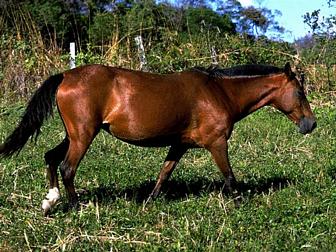
OVERVIEW
When the Conquistadors invaded Central and South America in the 1500s, they brought riding horses which were among Spain's finest. Inevitably many horses either escaped or were scattered during battles. Many of these horses survived in the vast pompas of South America. In this sometimes harsh and hostile environment, only the strongest survived to pass on their superior characteristics to their progeny. The breed of horse which is derived from these wild horses is the Criollo. The Criollo is found throughout South America but most prominently in Peru and Argentina. The Criollo has been used in many capacities, both as a cavalry mount and as the Gaucho's pony.
PHYSICAL DESCRIPTION
The Criollo has a medium-sized head fixed to a deep muscular neck. The back is short and the ribs are wellsprung. The quarters are ample and muscular. It has very little cannon bone and its legs are clean. Chestnuts appear only in the area of the hocks. The Criollo stands between 13.3 and 15 hands. The most prevalent color is dun with stripes, palomino and pinto.
ORIGIN
The origin of the Criollo is traced back to the horses brought to the Americas by the Conquistadors. The Criollo is found in many countries of South America.
INTERESTING FACTS
Two famous Criollos, "Mancha" and "Gato," were ridden 13, 350 miles between Buenos Aires and New York. This journey brought them to an altitude of 19,250 feet at one point. They also crossed 93 miles of desert in Ecuador in 120 degree heat without water. Annually, there is an endurance ride in Argentina for Criollos which lasts 15 days and covers 470 miles (750 km). The horses must carry 242 pounds (110 kg) and are allowed no food other than that found along the trail.
INFLUENCES
1. Spanish
For more information:
Criollo, Petsio Argentino
Sociedad Rural Argentina
Florida 460
(1005) Buenos Aris, Argentina